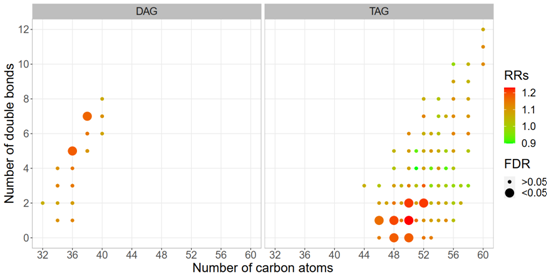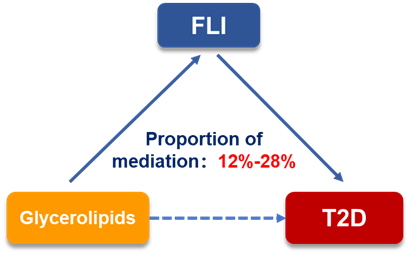Researchers Reveal Associations of Glycerolipids, Fatty Liver Index with Type 2 Diabetes in Chinese Population
On Mar. 12, 2021, Journal of Clinical Endocrinology and Metabolism online published the work entitled "Circulating Glycerolipids, Fatty Liver Index and Incidence of Type 2 Diabetes: A Prospective Study among Chinese". This is the first largest prospective cohort study to elucidate the role of fatty liver in glycerolipids-type 2 diabetes (T2D) associations.
Glycerolipids are the largest energy store and a major lipid class composed mainly of monoacylglycerols (MAGs), diacylglycerols (DAGs), and triacylglycerols (TAGs) in human. As second messengers, intracellular DAGs are biologically active lipids to induce insulin resistance. Emerging evidence also supports regulatory roles of TAGs in fatty acid oxidation and lipid synthesis. However, prospective study regarding to the relations of circulating glycerolipids with T2D is sparse, and the complex pathophysiologic mechanism about how perturbed glycerolipid metabolism promotes the onset of T2D is not well understood.
This study was joint efforts by Prof. ZONG Geng and LIN Xu’s research groups at the Shanghai Institute of Nutrition and Health (SINH), of the Chinese Academy of Sciences (CAS), and Prof. ZENG Rong’s group from CAS Center for Excellence in Molecular Cell Science. A targeted quantitative lipidomics method based on HPLC-ESI-MS/MRM was applied to detect 104 glycerolipids in the cohort sample of the Nutrition and Health of Aging Population in China established by Prof. LIN Xu’s team.
Researchers analyzed the prospective associations of plasma glycerolipids with 6-year incident T2D among participants who completed both baseline and a 6-yearr follow-up survey. They found that among 1,781 participants free of T2D at baseline, increased 9 plasma glycerolipids, including 2 DAGs and 7 TAGs, were significantly associated with higher incident T2D with relative risks:1.16-1.23, independently of conventional risk factors including HbA1c at baseline. The associations turned to be stronger for TAGs with lower carbon atom numbers (C46-C52) and fewer double bonds (n [C = C] = 0-2). Fatty liver index (FLI) calculated based on waist circumference, BMI, total fasting plasma triglycerides and γ-glutamyl transpeptidase (GGT) was positively associated with T2D risk with relative risks:1.43, and 8 out of the 9 diabetes-associated glycerolipids were positively associated with incident elevated FLI risk with relative risks: 1.19-1.51. Multiple mediation model suggested that the FLI explained 12%-28% glycerolipids-T2D associations.
In summary, this study suggested that specific types of glycerolipids might serve as early biomarkers and intervention targets related to T2D development in future clinical settings, and also provide further insight into the critical role of fatty liver linking glycerolipids to pathogenesis of diabetes.
This work was led by Prof. ZONG Geng and Prof. LIN Xu, and mainly conducted by Ph.D. candidate NIU Zhenhua in Prof. LIN’s group, collaborated with Prof. ZENG Rong as the co-corresponding author, and with WU QingQing at CAS Center for Excellence in Molecular Cell Science as the co-first author.
This study was funded by the Major Project of the Ministry of Science and Technology of China the National Natural Science Foundation of China, and CAS.

Glycerolipid profiles and risk of incident type 2 diabetes. (Image provided by Prof. LIN's Group)

Fatty liver partially explained glycerolipids-T2D associations. (Image provided by Prof. LIN's Group)
Media Contact:
WANG Jin (Ms.)
Shanghai Institute of Nutrition and Health,
Chinese Academy of Sciences
Email: sibssc@sibs.ac.cn
Web: http://english.sinh.cas.cn/
